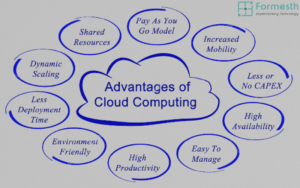Navigating The Cloud A Comprehensive Guide To Cloud Computing
Cloud Computing has been a popular topic of discussion for times now, and it’s no surprise why. With the power to store and access data from anywhere in the world, the possibilities for businesses are putatively endless. In this blog post, we’ll be looking at the sways and outs of Cloud Computing, furnishing compendiums with a comprehensive companion to understanding the technology and how to make the utmost of it. We will cover everything from the basics of Cloud Computing, to tips and tricks for maximizing its eventuality. So, whether you are a freshman or an educated stoner, this post is sure to have a commodity for you.
1.What’s Cloud Computing?

Cloud Computing is a revolutionary technology that has converted the way we store, access, and manage data. But what exactly is Cloud Computing? In simple terms, it refers to the practice of using a network of remote waiters, hosted on the internet, to store, manage, and process data rather than using an original garçon or particular computer. These remote waiters are known as the “cloud” and can be penetrated from anywhere with an internet connection.
Cloud Computing offers a range of benefits, including increased scalability, inflexibility, and cost- effectiveness. With cloud- grounded services, businesses can fluently gauge their Infrastructure up or down depending on their requirements, saving on outspoken tackle and conservation costs. It also allows for flawless collaboration, as brigades can pierce and work on the same lines and operations contemporaneously, anyhow of their physical position.
Overall, Cloud Computing has revolutionized the way businesses operate, enabling them to use the power of the cloud to streamline their operations, enhance productivity, and stay competitive in the moment’s digital geography.
2.Advantages of Cloud Computing

Cloud Computing offers a multitude of benefits for businesses of all sizes. One of the major advantages is the scalability it provides. With traditional IT structure, spanning up or down can be time- consuming and expensive. Still, with Cloud Computing, businesses can fluently acclimate their storehouse and computing coffers to meet their current requirements, ensuring they only pay for what they use.
Another crucial benefit is the inflexibility that Cloud Computing offers. It allows workers to pierce data and operations from any device with an internet connection, enabling remote work and adding productivity. This inflexibility also extends to collaboration, as brigades can work on the same lines contemporaneously, anyhow of their position.
Cost- effectiveness is another advantage of Cloud Computing. Businesses can avoid outspoken costs for tackle and software by exercising cloud- grounded services. They also save on conservation and functional costs, as the cloud provider takes care of Infrastructure updates and security measures. Cloud Computing also enhances data security and disaster recovery capabilities. Cloud providers employ strict security measures to cover data and insure business durability in the event of a disaster.
Overall, Cloud Computing provides businesses with the dexterity, scalability, cost- effectiveness, and security they need to thrive in the moment’s presto- paced and competitive digital geography.
3.Types of Cloud Services

Cloud Computing offers a range of services to feed to different business requirements. Let’s explore some of the most common types of cloud services available at the moment.
1.Infrastructure as a Service( IaaS): IaaS provides businesses with virtualized computing coffers, including virtual machines, storehouses, and networks. It allows companies to have further control over their Infrastructure while avoiding the costs and complications associated with managing physical tackle.
2.Platform as a Service( PaaS): PaaS is a cloud service that provides a platform for developing, running, and managing operations. It provides inventors with the necessary tools and coffers to make and emplace operations without having to worry about managing the underpinning infrastructure.
3.Software as a Service( SaaS): SaaS is a cloud service that offers access to software operations over the internet. Rather than copying and installing software on individual computers, druggies can pierce and use operations directly from the cloud. Popular exemplifications of SaaS include client relationship operation( CRM) systems, design operation tools, and dispatch services.
4.Storage as a Service( STaaS): STaaS allows businesses to store and pierce their data in the cloud. It eliminates the need for physical storehouse bias and provides scalable and secure storehouse options for businesses of all sizes.
These are just a many examples of the types of cloud services available. Each type offers unique advantages and can be acclimatized to meet specific business conditions. By understanding the different types of cloud services, businesses can choose the one that fits their requirements and helps them maximize the benefits of Cloud Computing.
4.Public, Private and Hybrid shadows

Public, Private and Hybrid shadows are different deployment models that businesses can choose from when espousing Cloud Computing. Each model offers unique features and benefits, allowing businesses to customize their cloud terrain to suit their specific requirements.
Public Cloud is the most common deployment model, where cloud services are handed by a third- party cloud provider over the internet. It offers scalability, inflexibility, and cost- effectiveness, making it an ideal choice for small to medium- sized businesses. Public Cloud also allows businesses to fluently pierce a wide range of services and coffers without having to invest in precious structure.
Private cloud, on the other hand, is devoted to a single association and is generally hosted on- demesne or in a data center. It provides lesser control and customization options, as well as enhanced security and sequestration. Private cloud is frequently chosen by large enterprises or associations with specific compliance or nonsupervisory conditions.
Hybrid cloud is a combination of both public and private shadows, allowing businesses to take advantage of the benefits offered by both models. It provides inflexibility and scalability by allowing associations to use public cloud services for non-sensitive workloads, while keeping sensitive data and critical operations in a private cloud terrain.
Hybrid cloud offers the stylish of both worlds, furnishing businesses with the dexterity and cost- effectiveness of a public cloud, as well as the control and security of a private cloud. When choosing between these deployment models, businesses should consider their specific conditions, budget, and data perceptivity.
It’s important to assess the benefits and limitations of each model and determine which one aligns stylishly with their business pretensions and objects. Whether it’s the inflexibility and scalability of a public cloud, the control and security of a private cloud, or the combination of both in a cold-blooded cloud terrain, businesses have a range of options to choose from when it comes to Cloud Computing deployment. The key is to find the right balance that meets their requirements and allows them to maximize the benefits of the cloud.
Conclusion:
Navigating the Cloud: A Comprehensive Guide to Cloud Computing Cloud Computing has been a popular topic of discussion for times now, and it’s no surprise why. In this blog post, we will be looking at the sways and outs of Cloud Computing, furnishing compendiums with a comprehensive companion to understanding the technology and how to make the utmost of it. Storage as a Service STaaS allows businesses to store and pierce their data in the cloud.
Also Read: Strategic Brilliance Unleashing The Power Of Marketing Management For Business Success
Also Read: Dominate the Online Space How to Master SEO like a Pro
